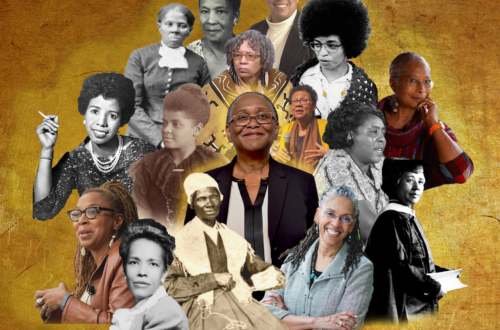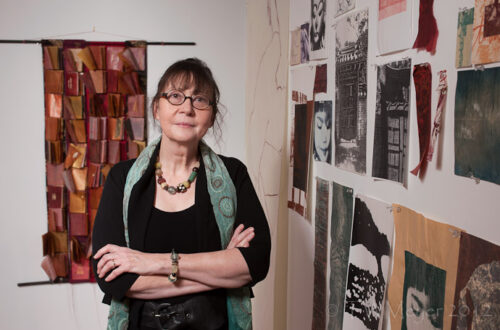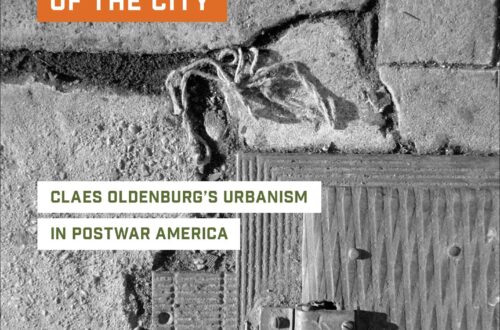
Celebrating the Writers’ Festival: A Conversation with Nicole Stamant
With the 50th Agnes Scott College Writers’ Festival coming up, English Professor and Department Chair Dr. Nicole Stamant is looking back at Festival archives. A lucky few—the English department, select alumni, and some faculty—have been receiving Stamant’s near-weekly emails (subject line “This Week in Celebrating the Writers’ Festival”) since January containing curated bits of the Writers’ Festival records. Full of essential ASC history, reading recommendations, and Stamant’s charm, the series is also available on the Writers’ Festival WordPress Site. I met with Dr. Stamant over Zoom to learn more about Festival highlights past, present, and future.
LP: What’s the value of looking back into these archives at Writers’ Festival history? What can we learn?
NS: Having the chance to really think deeply about what students were writing about every year has been absolutely extraordinary. Thinking about, for example, the way the Vietnam War influenced student writing through the 70s and 80s has been not surprising, but it’s also not something I think about in the throes of the Festival contest every year. In the set that I was looking at for this week—which is 1980-1984—the students are writing super postmodern poems. They are messing with capitalization, and they’re messing with space on the page, and they’re doing things in the moment that I recognize as a literary scholar of postmodernist writing. I should have known that is what I would find, but I wasn’t thinking about it in that way.
It’s also been really fun to see how the contest and how the magazine has changed over the years. The first many years, it was a special issue of Aurora. In 1981, they stopped doing that, and it became a standalone magazine. The magazine added creative nonfiction in the mid 90s and dramatic writing in the late 90s. It’s been a real treat to watch the shift in how we’re thinking about writing.
LP: It seems like there are so many big names that are somehow connected to the Writers’ Festival in some way, and it’s very cool and sometimes shocking. I was wondering, who was the most surprising to you to find in the archives?
NS: I think Margaret Atwood is probably the biggest surprise. She came in 1982, well before The Handmaid’s Tale. We have her recorded, and the person introducing her says something like, “You might be wondering why this Canadian novelist is here,” and I was thinking, no one now would wonder why Margaret Atwood was there. Now everybody in the world knows who Margaret Atwood is, and here she was in 1982, relatively unknown.
LP: I think Atwood was the biggest surprise for me too.
NS: I think it was a surprise that Robert Penn Warren was one of the first Writers’ Festival guests. As a literary critic, poet, and novelist, Warren has a very outsized presence in American literature. From the very beginning, the Agnes Scott College Writers’ Festival had its finger on the pulse of what was important in contemporary American literature.
One of the other things that has been really delightful is looking at how the Writers’ Festival guests are chosen to be guests before they really make it big. For example, even though Rita Dove came after she had won the Pulitzer for Thomas and Beulah, she talks at the 1991 Writers’ Festival about how she had been trying to come to the Festival for many years. Similarly, Tracy K. Smith came right around the time that she won awards. It’s not like the writer wins the award, and then they come to Agnes Scott [College], but rather, they end up coming a couple of years before they make it really big. The number of times that that happens is something I was surprised by and delighted by! Having Joy Harjo come as part of the 2012 Festival many years before she was the first American Indian Poet Laureate is a testimony to the ways the departmental choices for the Writers’ Festival speak to larger national concerns. And, I think it’s lovely to watch how important these writers have become to American literature, not just how important they were in that moment. Now, you can’t teach a class on American literature without Joy Harjo—I mean, you shouldn’t!
LP: What are some highlights you’re looking forward to from this year’s Festival?
NS: I am looking forward to the event with the students. That’s always one of my very favorites. I’m obviously really excited about Rita Dove; I want to hear what she’s doing now. For this year, I’m excited for the performance of The Arsonists by Jacqueline Goldfinger ‘00, which is something unusual. We’ve had quasi-staged plays, especially Goldfinger’s work before, but nothing like a full-scale production. Of course, we had imagined it would be in person, but there’s only so much that can be done in a pandemic. I still wish it were in person, but we’re really excited about the possibilities of the streaming performance.
I’m also looking forward to the “From the Archives” series. It’s been such a delight to not only go back through the archives of the magazine, but through the old videos we have. I have loved watching Rita Dove, Melissa Fay Greene, and Memye Curtis Tucker ‘56. There is only one that we’re showing that I was in attendance at; it was the 2013 Writers’ Festival. My husband and I were rewatching the Q&A session from the 2013 Festival, and I know the students who are asking those questions, and I’m as proud of them now as I was in the moment. Anna Cabe ‘13 is the first person who asks a question of Cristina Garicia. Those are the moments where things spark for students. To watch Anna Cabe ask questions of Gish Jen and Cristina Garcia, knowing that Anna Cabe comes back as a Festival guest? This kind of thing is so extraordinary.
I love the opportunity to show everybody—including Agnes Scott [College] student writers past, present, and future—what our students can do. Our literary future lies with the student writers; this is where we’re going next. And I have felt that way from the beginning of my involvement with the Writers’ Festival, but now I know it to be true for certain after having looked at so many of these magazines and seeing where so many of these writers go.
The Agnes Scott College 50th Annual Writers’ Festival took place from April 5- April 9, 2021. To learn more about the Writers’ Festival, visit: https://www.agnesscott.edu/writersfestival/
To enjoy recordings of the festival’s events, visit: https://www.youtube.com/channel/UCC47CSufxPOgU00MyDMuppg
Dr. Nicole Stamant’s work takes as its primary focus historically marginalized populations and historically marginalized forms of literature: Life Writing Studies, ethnic American literatures, and the literatures of gender and sexual minorities. She is the author of Serial Memoir: Archiving American Lives (Palgrave 2014), and her journal articles on gender, race, ethnicity, trauma, foodways, and graphic narrative have appeared in ARIEL, MELUS, a/b: Auto/Biography, South Central Review, The Hemingway Review, and Studies in Comics among others. Most recently, she has contributed to the edited collections American Literature in Transition: 1970–1980(2018) and The Postcolonial Subject in Transit: Migration, Borders, and Subjectivity in African Diaspora Literature (2018). She is currently working on a book manuscript, titled “Light, Bright, Mixed, Mulatto, Biracial, Black: Memoirs of Race, Color, and Belonging,” which looks at a number of contemporary memoirs by African Americans through the lenses of hospitality and hauntology about their experiences being light-skinned and/or biracial. This manuscript project also incorporates creative nonfiction: biographical and autobiographical sketches of Stamant’s own family and ancestral history. In 2018, she received Agnes Scott College’s Vulcan Materials Company Teaching Excellence Award.




